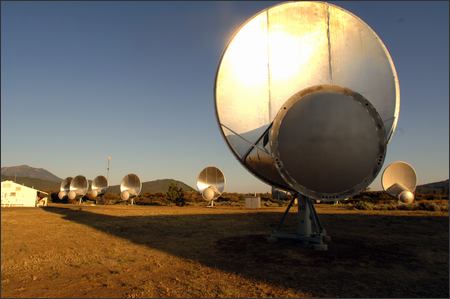| Tweet |


ポール・アレン氏の寄付によってカリフォルニア州ハット・クリークに建設された”ET探索用”の42台の電波望遠鏡
(Photo courtesy of SETI and the University of California, Berkeley)
----------------------------------------------------------------------------
ビル・ゲイツ氏とともにマイクロ・ソフト社を設立した億万長者、ポール・アレン氏の夢であった”ET探索用”(=異星からのシグナルをキャッチするため)の大型電波望遠鏡がこの度、完成。カリフォルニア州ハット・クリークに42台設置された。
これに関わったのは、カリフォルニア大学バークレー校のレオ・ブリッツ博士、シリコンバレーにあるSETI( (the Search for Extraterrestrial Intelligence)Instituteの セス・ショスタック博士が率いる科学者たち。
この約12年間の間は750の異星からのシグナルしか受理できなかったが、今後20年間の間で、約100万個以上の異星からのシグナルをキャッチできるようになるだろうと言っている。
アレン氏は、このプロジェクトの為、2001年に1,150万ドル、2003年にポール・アレン財団から1,350万ドルを寄付した。
http://seattlepi.nwsource.com/local/335023_allenscope12.html
Paul Allen's tools for finding ET to be harnessed for new uses
By TOM PAULSON
P-I REPORTER
There's no sign yet of ET, but an innovative network of radio telescope dishes largely funded by Seattle billionaire Paul Allen and aimed into space from a remote site in Northern California is expected to soon prove its value for addressing more routine astronomical questions.
· Stretching the Search for Signs of Life (New York Times)
"This opens up a whole area in science," said Leo Blitz, director of the radio astronomy laboratory at the University of California-Berkeley.
"Nobody had ever tried this approach before," said Allen, who joined Blitz, scientists from SETI (the Search for Extraterrestrial Intelligence) and other organizations Thursday to officially activate the first phase of the Allen Telescope Array in Hat Creek, Calif.
"The array in its first two decades will be able to check out more than a million star systems," said Seth Shostak, a lead astronomer at the SETI Institute in Mountain View, Calif.
In the past dozen years, Shostak said, SETI has been able to carefully look for radio signals of about 750 star systems. He suggested comparing the SETI search so far to Jodie Foster's role as a scientist in the 1997 movie "Contact," in which she was sitting in the desert personally listening for telltale radio signals from some distant civilization.
"The Allen Telescope Array will be like 200 million Jodie Fosters sitting out there listening," Shostak said.
"We will be able to look at a much larger piece of the sky," said Blitz, adding that the sky survey can also be done much more rapidly, allowing scientists a much greater chance to capture and study transient phenomena in space such as exploding gamma ray bursts.
"They are the most energetic explosions we know of in the universe and we still really don't know what they are," he said.
Blitz said the new telescope array could also identify new phenomena now missed by the static, narrow focus of many other telescopes.
Allen, the Microsoft co-founder, helped SETI and UC-Berkeley launch the project in 2001 with an $11.5 million donation. In 2003, the Paul G. Allen Foundation donated another $13.5 million to begin construction of the ATA, as it is known. Many believe that without Allen's support for this project, SETI might have had to cease operations.
At the Thursday event in Hat Creek, Allen and the others officially started the first phase of scientific observations by activating 42 separate radio dishes spread across the arid mountain landscape.
Most radio telescopes are extremely large, single dishes. The ATA, like some other telescopes, will be a network of 350 dishes when finished. These fairly simple, 20-foot-diameter dishes can be moved around the landscape to collect radio signals. The signals are fed into a sophisticated computerized system for digital analysis.
"They're like souped-up, old-style TV dishes that, gathered together using state-of-the-art electronics and computing, create a very powerful and flexible radio telescope," Allen said in an interview with the Seattle P-I earlier this week. "SETI is the long shot of long shots, but we can also use this for regular radio astronomy."
Blitz said his graduate students have already obtained valuable new information by doing radio astronomical observations of hydrogen gas clouds in two nearby galaxies, Andromeda and Triangulum.
"We want to understand how galaxies evolve," Blitz said. "It's a hot topic in astronomy today."
The total cost of the project so far is estimated at $50 million. Allen's foundation paid half of that while SETI, UC-Berkeley, the National Science Foundation, former Microsoft executive Nathan Myhrvold and others contributed the balance. Further funding will be necessary for the project to be completed in three years, as planned.
"We've proved it can work," said Allen, adding that he may contribute more money to the project. "I'm hopeful that given the many uses of this telescope, others will be interested in funding it as well."
P-I reporter Tom Paulson can be reached at 206-448-8318 or tompaulson@seattlepi.com.
|
|
▲このページのTOPへ HOME > Ψ空耳の丘Ψ50掲示板
フォローアップ:
|
|
投稿コメント全ログ コメント即時配信 スレ建て依頼 削除コメント確認方法
|
|
 題名には必ず「阿修羅さんへ」と記述してください。
題名には必ず「阿修羅さんへ」と記述してください。
掲示板,MLを含むこのサイトすべての
一切の引用、転載、リンクを許可いたします。確認メールは不要です。
引用元リンクを表示してください。
|
|
|
|
|
|
|
|